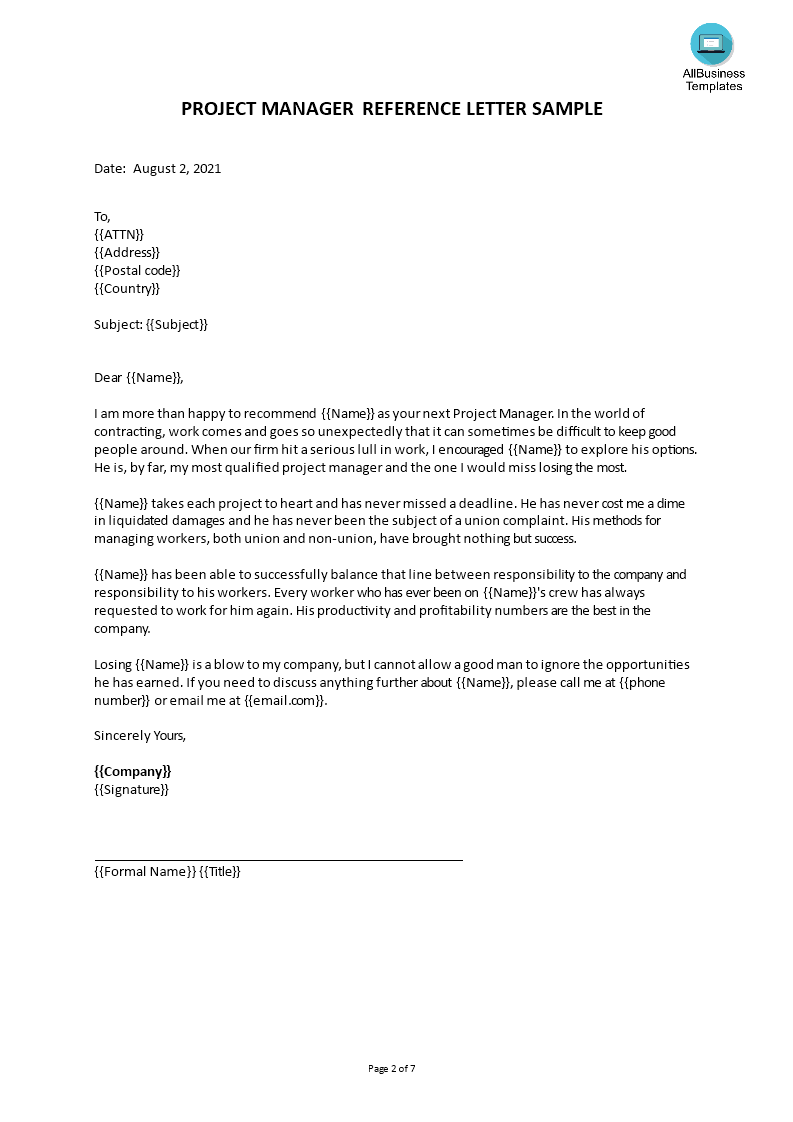Professional Reference
Save, fill-In The Blanks, Print, Done!

Download Professional Reference
Microsoft Word (.docx)Or select the format you want and we convert it for you for free:
- This Document Has Been Certified by a Professional
- 100% customizable
- This is a digital download (81.08 kB)
- Language: English
- We recommend downloading this file onto your computer.
What is a professional reference? How do you write a reference letter?
A professional reference is a recommendation from a person who can vouch for your qualifications for a job. A professional reference for an experienced worker is typically a former employer, a colleague, a client, a vendor, a supervisor, or someone else who can recommend you for employment.
Recent college graduates might also tap professors, coaches, and college personnel who were advisers for your activities. The key is picking references who have observed you acting in a productive capacity where you displayed your skills and credentials for employment.
These differ from personal or character references, which are much more personal references. The professional reference is speaking mainly to the applicant’s employability and work-related qualities, as opposed to their personal or character traits. Personal references may be helpful at times, but don’t be tempted to submit a personal reference as a substitute when the job listing or interviewer specifically requires a professional reference
How do you write a good reference letter for a coworker?
Consider the following format and writing suggestions when you draft a reference letter for a co-worker, friend, or staff member.
Reference for First Name and Last Name:
Salutation
- If you are writing a personal letter of reference, include a salutation (Dear {{Name}}).
- If you are writing a general reference letter, say “To Whom It May Concern" or simply don't include a salutation.
Paragraph 1
- The first paragraph of the reference letter explains your connection to the person you are recommending, including how you know them, how long you have known them, and why you are qualified to write a reference letter to recommend them for employment or graduate school.
Paragraph 2
- The second paragraph of the reference letter contains specific information about the person you are recommending, including why they are qualified, what they can contribute, and why you are providing a reference letter.
- Be sure to use specific examples to speak to their qualifications. If necessary, use more than one paragraph to provide details.
Summary
- This section of the reference letter (typically right before the conclusion) contains a brief summary of why you are recommending the person.
- State that you "recommend without reservation" or "highly recommend" the person or something similar.
Conclusion
- The concluding paragraph of the reference letter contains an offer to provide more information. Include a phone number within the paragraph.
- Also include your phone number and email address in the return address section of a hard copy letter or, if you're sending an email, underneath your name in the signature.
- See a sample signature for a hard copy letter in the download file.
- Sincerely,
- Signature
- Writer Name
- Title
- It has been a pleasure to have {{him/her}} at our school. {{He/she}} is most deserving of this award.
- Thanking you.
- Yours sincerely,
What makes a good recommendation letter?
- Enthusiastic! Show off the character and personality of the person;
- Provide descriptions of your contributions to the work/academic environment related to completed tasks on time or your strengths;
- Always use action verbs to describe your accomplishments, skills, and strengths;
- Make sure to use the active voice which indicates that you completed tasks and demonstrated desirable behaviors. Since the passive voice can indicate that events happened with or without your active involvement;
- Explain how you performed the responsibilities required, and therefore it’s good to study some appealing anecdotes;
- If possible, a statement indicating people would re-hire you or collaborate with you on another project;
- Structured and written to highlight the person's strengths;
- Immediately clear about the purpose and position the person is seeking;
- Brief, preferably one or pages in length;
- Clean, error-free, and easy to read;
- Using common business letter format;
- No copying of exact words/phrases from sample letters without checking the context;
- Uses the correct name of the University or organization;
- Contact information including his or her full name, appropriate title, address, phone number, and/or e-mail address;
- Expands upon their resume; do not repeat it verbatim in your reference letter as well.
Keep in mind that this example reference letter is only a basic and simple letter template. You should spend some effort in tweaking the letter and add some of your own creativity and personality to it. In fact, we encourage you to do so!
Download this useful Reference letter format now.
DISCLAIMER
Nothing on this site shall be considered legal advice and no attorney-client relationship is established.
Leave a Reply. If you have any questions or remarks, feel free to post them below.
Related templates
Latest templates
Latest topics
- GDPR Compliance Templates
What do you need to become GDPR compliant? Are you looking for useful GDPR document templates to make you compliant? All these compliance documents will be available to download instantly... - Google Docs Templates
How to create documents in Google Docs? We provide Google Docs compatible template and these are the reasons why it's useful to work with Google Docs... - IT Security Standards Kit
What are IT Security Standards? Check out our collection of this newly updated IT Security Kit Standard templates, including policies, controls, processes, checklists, procedures and other documents. - Letter Format
How to format a letter? Here is a brief overview of common letter formats and templates in USA and UK and get inspirited immediately! - Google Sheets Templates
How to work with Google Sheets templates? Where to download useful Google Sheets templates? Check out our samples here.
cheese

